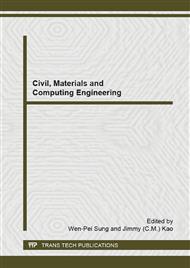p.195
p.198
p.202
p.207
p.212
p.220
p.226
p.233
p.237
Experimental Research on Dynamic Behavior of the Masonry Pagoda Based on Soil-Structure Interaction
Abstract:
Most of ancient pagodas were damaged by earthquakes, and the dynamic behavior is a key factor to determine the seismic strengthening scheme of the pagodas. This research selected a typical masonry pagoda as the object, combined free vibration test with numerical simulation to discuss the influence of dimension change of ground base on dynamic behavior of the pagoda, as well as the construction method of the FEA model based on the soil-structure interaction. The dynamic behavior tested from a 1:15 reduced scale of physical model indicated: comparing with the condition of pagoda pedestal is fixed, the natural frequency of the superstructure is decreasing with the increase of thickness of ground base,which shows the “soft effect” of ground soil to structural stiffness. The influence degree of thickness and plan size of ground base to dynamic behavior of the physical model are simulated by program ANSYS, and the effective dimension range of ground base for the FE analysis of pagodas has been proposed.
Info:
Periodical:
Pages:
212-219
Citation:
Online since:
December 2014
Authors:
Price:
Сopyright:
© 2015 Trans Tech Publications Ltd. All Rights Reserved
Share:
Citation:


